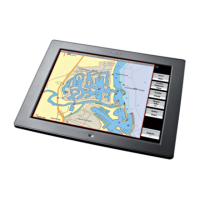• Select the layout type. Select
Next.
◦ Choose the content for each pane from the list of
applications displayed. After selecting the application for the
current highlighted pane (indicated by a red border).
Change focus to another pane by using the arrow keys on
the OP30. Once again, select an application from the list to
be displayed in this pane.
◦ Select Edit. Use the on-screen keyboard to enter a new
name. Select OK.
◦ Show or hide the instrument bar.
• Select
Save.
1.7 Controllers - OP30 remote/USB mouse
The GB40 can be operated using a SIMRAD OP30 remote control
(this is the preferred option) or by using a USB mouse. These
devices are called
controllers.
Note: At least one controller must be present in the network
when powered up for the first time.
OP30
The OP30 has several dedicated shortcut and feature buttons
that can access common features quickly. Each GB40 on the
network can be set up to accept or ignore key presses from any
OP30 on the network.
USB Mouse
Plugging in a USB mouse introduces an extra set of buttons on
screen.
Using a USB mouse can be a very convenient way to quickly
negotiate through the GB40s onscreen menus and buttons.
However, each mouse can only operate the GB40 it is plugged
into. The GB40 registers "left-click" or single-button clicks and
dragging, but not double-clicks.
If you're using a mouse on the same system as an OP30
controller, right click the mouse each time you use it after having
used the OP30. This will put the system back into the correct
mode for mouse usage.
Note: When a GB40 detects a mouse, an extra set of buttons
above the main pane appears. These buttons are shortcuts to
12 | Welcome to the GB40

